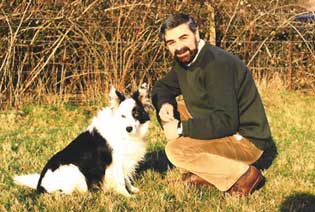As the breeders are friends of ours, they tried a little emotional blackmail. "If we can’t find her a good home, we’ll have to put her to sleep." It worked, as on 14 July 1988, we collected Lady and brought her home.
I had grand ideas about training Lady to a good pet dog standard of obedience despite her disability, but where do I start? I had been to dog clubs before with my other dogs and the only method of training I knew was the hands-on, squish, squash, push-me, pull-you methods, so that was the method I started to use. These training sessions were painful experiences for me, as Lady was a particularly mouthy puppy and she was more interested in chewing bits off my fingers than learning. It then dawned on me that I wasn’t actually teaching her anything. As she couldn’t hear, I couldn’t reinforce the ‘sit’ position with a verbal command, and I was too busy pushing her into position, I couldn’t reinforce it with a hand signal.
I was now at a point where, I suspect, many owners of deaf dogs arrive. HELP!! The dream of having an obedient deaf dog was turning into a nightmare. My sweet, innocent, cuddly puppy was turning into a doggie delinquent. Where do I go for help? The vet? The local dog club? Perhaps the book shops or the library had a book on the subject. But no. Everybody I spoke to told me to have Lady put to sleep. "You can’t train a deaf dog", I was told, and like many deaf dog owners, I did considered having her put to sleep, as well as re-homing her or taking her back to the breeder. But I wasn’t prepared to give up yet. If only I could find a hands-free method of training.
Then, purely by chance, I watched a puppy training video by Dr Ian Dunbar. He was getting a puppy to sit, lie down, to come to him, and to walk by his side without a lead, all by using a food treat, and not one finger came into contact with the puppy. This had to be worth trying. So I held a food treat slightly over Lady’s nose and moved it back towards her eyes. As her head went up looking at the treat, her rump went down and she was sitting. Eureka! Then by moving the treat away from her, level with her nose, she stood, and by placing the treat on the floor between her paws, she laid down. At last, I was seeing some progress. In a short space of time, Lady was following my hand with the treat into the three positions of sit, down and stand. It didn’t take too much imagination to convert the hand movements into hand signals and before too long, I could dispense with the food lure and just use a hand signal.
Probably the most important lesson I learned during the initial few months of training was that I must be able to get, and keep, Lady’s attention. During our frequent training sessions I would use food treats or toys to get her attention and then use them to reward her when she did something right. When owners of deaf dogs ask my advice or come to me for training, the first piece of advice I give them is to find something, ideally a number of things, the dog really, really likes.
I was now on a roll; I had made some progress. Hand signals, body posture and facial expression all played a part in communicating with Lady. I developed clear, simple and exaggerated hand signals that she could see from a distance. When she got something right, I would say, ‘good dog’ with real feeling and my face would light up. Eventually she learnt that a smile meant I was pleased with her. Equally, she learnt that a scowl meant she was doing something wrong.
One of the most important things probably every dog owner wants from their dog, is for it to come back when called. I made the mistake of letting Lady off-lead without having trained her to come back to me. I thought she would want to stay with me because I’m a nice guy - honest! I was wrong. Anything was more interesting than I was. Having found out that Lady likes to chase horses, birds, falling leaves, in fact anything that moves (after all, she is a Border Collie), I had to go back to the drawing board and work out a training programme for a ‘recall’. Using Lady’s obsession with a ball, I taught her to pay attention to me. I then taught her a recall signal. When she obeyed the recall signal, she was rewarded with a play with the ball. Now on our walks, Lady is off-lead most of the time, but only in safe areas.
Training a deaf dog is not easy. However, due to my experiences with Lady, I have been able to help many other owners, and their deaf dogs, through my training book, Hear, Hear! and through one-to-one training. It’s a great shame there are deaf puppies at all, but unless deafness can be totally eradicated from blood lines, there will always be people who are willing to give deaf dogs a chance of a normal life. Those people and their dogs need help, but there isn’t lot of it about. Instead of turning our backs on the problem, let’s get to grips with it and offer positive help.
It is possible to train a deaf dog given the right environment, the right type of owner and using the right training methods. But it’s not easy. There are no short cuts, quick fixes or magic formulae, but ultimately it is exceedingly rewarding.
|





